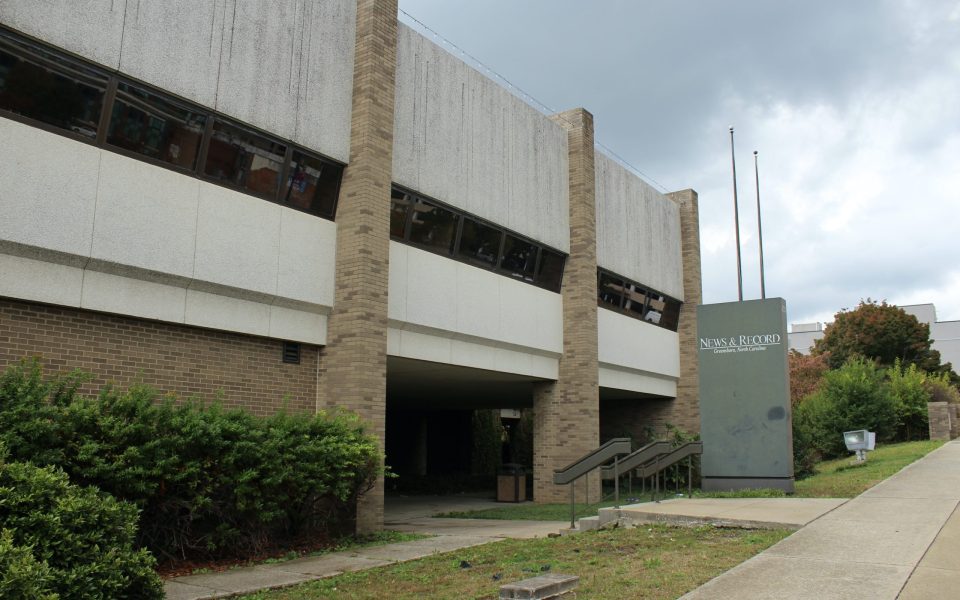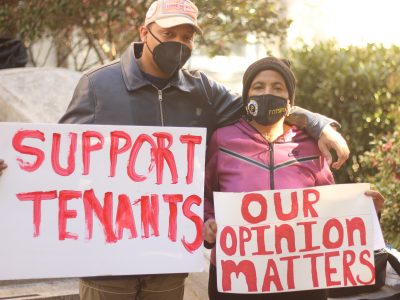Shards of broken glass from discarded bottles, stacks of old newspaper and an active brownfield are just a few of the problems marring the vacant building that sits at 200 E. Market St. in downtown Greensboro, once the headquarters of the city’s daily newspaper, the News & Record.
Spanning more than six acres with a tax value of $9.4 million, the lot is one of the largest, most expensive sites in the city’s downtown area. And with its problems, a few residents and downtown business owners are wondering what the future of the site may look like.
The N&R is currently owned by Lee Enterprises, who bought it from BH Media last summer. The staff of the paper moved out of the building shortly afterwards in June and into their new space at 3001 S. Elm-Eugene St. Since the move, the building has sat empty, with a number of unhoused individuals claiming space in alcoves outside of the building and graffiti artists having their way with the exterior walls.
According to previous reporting by the N&R, the Triad Business Journal and the Rhino Times, the building has been up for sale since 2017, when the N&R closed down its presses and started printing the paper in Winston-Salem. The building, which is still owned by BH Media, was under contract to be sold to developer Greg Dillon in 2018. Dillon is the president of Dillon Development Partners out of Frederick, Md. and the driver behind a Westin Hotel and a parking deck that is currently being built opposite of the old N&R building on Davie Street.
However, earlier this year reporting by N&R and TBJ noted that the sale had fallen through. Now, months later, the property remains on the market, but reporting by Triad City Beat has found that problems with the site remain and could deter potential buyers from wanting to develop the property.
According to a list kept by the state’s Department of Environmental Quality, the former N&R site is an active, eligible brownfield. This means that the property is “abandoned, idled or underused where environmental contamination or perceived environmental contamination hinders redevelopment,” according to the state’s brownfield FAQ page. Developers may face difficulties obtaining loans for redevelopment of active brownfield sites because they come with “potential environmental cleanup liability.”
-

The News & Record building is an active brownfield meaning it has some environmental conditions that need to be remediated before it is developed. (photo by Sayaka Matsuoka) -

Since the location was vacated by staff last year, the property has been marred with trash and the remnants of unhoused individuals who have used the site as living quarters. (photo by Sayaka Matsuoka)
To alleviate some of those difficulties, the state has what is called a “brownfield program” in which developers can enter an agreement with the state to clean up the site so they can then redevelop it. The process is also meant to help developers be able to obtain project financing more easily.
According to documents listed on the state’s brownfield website, the 200 E. Market St. property was previously part of a brownfield agreement between the state and ESC Redevelopment LLC in 2019. While Daniel Robinson is listed as the point of contact for ESC Redevelopment LLC on many of the documents regarding the agreement, a Gregory Dillon is also listed as a managing member of the company for ESC’s state business filing. This possibly signifies Dillon’s involvement in the brownfield agreement as part of the contract to buy the property back in 2018.
As part of the agreement, ESC Redevelopment LLC hired Terracon Consultants, Inc to conduct an environmental site assessment of the property in October 2018. The resulting assessment, which is 131 pages long, noted that several businesses that existed on the property prior to the N&R building being constructed in 1976, may have resulted in some environmental contamination of the property. These include businesses such as a former bus station, auto sales, auto garage, air conditioning service and laundries. Five former on-site gasoline service stations were also found to have potentially impacted the soil or groundwater beneath the site.
According to Gene Mao, a hydrogeologist with Guilford County’s Public Health Department, there are four underground storage tanks on the property, one of which caused a spill in 1995. Mao noted that N&R conducted clean up for the underground tanks and the spill incident; the soil and groundwater met the state requirement afterwards.
However, according to data provided to TCB by Greensboro’s planning department, the property had five incidents reported between 1992 and 2013, but they were all listed as low levels of concern.
So, the question that remains is why if the spills were cleaned up and the soil and groundwater levels were deemed safe, is the property still on the state’s brownfield list as an active and eligible location? The answer could lie in the workplan documents from 2019 in which Terracon, the company hired by ESC Redevelopment LLC, outlined their plans to assess whether or not chemicals remain present onsite. Some of the specific concerns that Terracon listed in their plan were potential petroleum, solvent and hydraulic fluid releases. Their plan, as of May 2019, was to conduct a full site assessment complete with soil samples and groundwater samples. However, with the falling through of the sale, it is unclear if the assessment ever took place.
And as such, the fact remains that the site is still listed as an active brownfield location.
‘An embarassment’ and ‘an eyesore’
Mayor Nancy Vaughan noted that the location, which currently acts as a diving line between the bustling Elm Street corridor and the quieter Davie and Church Streets, is “the most valuable piece of property available in downtown Greensboro.”
Listed as “available for sale” on real estate firm Cushman & Wakefield’s website, the property is currently on the market for close to $11 million. A brochure for the property notes Greensboro’s mark in the state as its third-largest city, home to multiple colleges and universities and dozens of high-profile companies such as Honda Aircraft, VF, Volvo Trucks of North America, The Fresh Market and more. And with the opening of the new Tanger Center downtown, Vaughan said she wants a developer to come in and transform the property into something that would “add to [Greensboro’s] tax base and [change] the skyline.” She noted that it could be turned into quality office space, which is still in demand, especially downtown.
Savannah Duban, a senior communications specialist for Cushman & Wakefield responded to TCB’s emails by stating that the company was “unable to comment on [the] article at this time.”
Zack Matheny, the CEO of Downtown Greensboro Inc., said that he’s had numerous calls with potential developers about the site since the sale with Dillon fell through this summer. In a call on Wednesday morning, Matheny said he has had three separate conversations about the site just this week.
“The interest on the News & Record site is tremendous,” Matheny said. “The potential for the site as a large development, a century development, a once-in-a-lifetime deal is exciting. The current state that the building is certainly disappointing but I’m looking at it in a stretch of what it will be and it’s a terrific opportunity.”
Matheny said that in the calls he’s had, developers are interested in taking the property and converting it into a multi-use site that could be for potential convention or meetings spaces, residential property or even another hotel. What he’s been pushing for however, is something a little different.
“I’m thinking a little bit bigger,” Matheny said. “Since the project does need work, that we as a municipality, whether the city or the county or the state maybe partner with us and do we think big and have a riverwalk on that site like Oklahoma City or San Antonio. People have always talked about water in downtown Greensboro, and we have a high water table. So could we develop a riverwalk on that 10-acre site and then sell the outparcels?”
The closest thing in North Carolina would be the water feature on the American Tobacco Campus in nearby Durham, but Matheny said he envisions something similar but “times that by 10.”
As for why the sale with Dillon fell through, Matheny didn’t offer any insight but noted that developing such a large property takes time and is a challenge. He also noted that he understands why some businesses past Davie Street might be frustrated with the current building’s state and its role as a separator in downtown.
“Certainly we want to create a better flow between downtown through to East Greensboro and the News & Record site is a major area of that,” Matheny said. “A, I got to get it cleaned up and B, we need to make sure we get something proper there and I think A&T frankly should be at the table; I think it’s a great project their students could be a part of.”
As for the site’s current issues, Matheny said it was disappointing but Mayor Vaughan noted that “it’s not unusual for older buildings to have environmental problems.” In fact, according to the state’s list of brownfield sites, the N&R building is one of five active brownfield locations in the city.
Still, Vaughan noted that “it would be good for the current owner to take that on, but it doesn’t appear that they have a desire to make it more marketable.”
-

Piles of old newspapers sit undisturbed on the property (photo by Sayaka Matsuoka) -

Trash and remnants of homeless living quarters remain (photo by Sayaka Matsuoka)
The owner of the property is listed on tax records as Greensboro News & Record Inc. A quick search of the business on the Secretary of State website shows that BH Media in Omaha, Neb., the N&R’s previous owner remains the current owner of the property. TCB could not reach a representative with BH for comment on this story.
Walking around the building on a recent Friday afternoon, wads of paper and plastic bags rustle across the ground next to old sleeping bags and empty plastic bottles. The main entrance of the building remains locked with a deadbolt and a crack runs along the right-side glass door. Around the corner, stacks of fading newspapers sit undisturbed. The site is quiet; birds that fly out of the bushes that flank the building remain the last signs of life on the property.
But 15 or 20 years ago, the place was bustling, says former N&R Editor John Robinson.
“At one time we had about 500 employees in that building,” Robinson said. “It operated about 18 hours a day.”
Robinson, who currently teaches journalism at UNC-Chapel Hill, worked at the paper from 1985-2011 and served as the editor from 1999 until he left. As a Greensboro resident and a former employee, he says he’s frustrated with the current state of the building.
“What’s happened to it is really a shame and it should embarrass BH Media,” Robinson said. “To know that it had so many employees that took great good care of it, you would think that BH Media, a multimillion-dollar company could come down and take care of the property. To see what it represented to Greensboro and how it has declined is an embarrassment as a former employee there.”
Robinson said that he thinks the city should buy the property and build something that would add to that part of downtown which has several museums and other cultural institutions. And he’s not the only one.
Queena McKee, the owner of Queen’s Royal Beauty Bar at 315 E. Market St. said she worked at the N&R in college, close to 20 years ago. At the time, she said the building acted as a bridge between the Elm Street part of downtown and the area past Davie Street because the paper employed so many people.
“When I was there, I would talk to everything,” she said. “It was a hub. I remember coming to businesses down here and now it’s different.”

McKee’s mother, Alice Wise, echoed her daughter’s feelings as she braided a client’s hair.
“What we’ve noticed is that they say we’re a part of downtown, but we don’t get the same consideration that the people on Elm Street do,” Wise said. “We could get more business if something did change.”
McKee said that she feels like the abandonment of the property impacts the flow and overall cohesion of downtown Greensboro.
“It’s kind of negative because people don’t realize there’s stuff down here,” she said. “They stop looking after they hit that building.”
Wise said that she would love to see the property transform into a small-business incubator or into affordable housing. Being a downtown business owner, she said she sees the plight of homeless individuals and wonders if the huge lot could be used in a way to help them. Whatever takes its place, it’s better than what’s there now, she said.
“It’s been an eyesore for a long time,” she said.
Join the First Amendment Society, a membership that goes directly to funding TCB‘s newsroom.
We believe that reporting can save the world.
The TCB First Amendment Society recognizes the vital role of a free, unfettered press with a bundling of local experiences designed to build community, and unique engagements with our newsroom that will help you understand, and shape, local journalism’s critical role in uplifting the people in our cities.
All revenue goes directly into the newsroom as reporters’ salaries and freelance commissions.





Leave a Reply